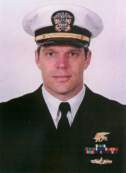Imagine one day, you're walking across a large parking lot at a military base and you look in the sky and see an object you've never seen before. It isn't flying but rather maintaining a fixed position overhead. It looks like a gray metallic pyramid or triangle and very light clouds are blowing by accentuating the stationary position of the object. Depending on your disposition, you might quickly dismiss it as perhaps a satellite or some object or space debris or maybe even a new military craft of some sort. Another approach might be to rapidly conclude it is from outer space and contains alien life forms. There's a range of possible reactions for a person in that situation depending on the person.
Suppose you shared your story with someone else. Would you expect them to believe you? Perhaps if they'd known you for a long time and trusted your pronouncements--family, friends, etc. But if they didn't know you, you'd have a low level of trust and could understandably be at peace if they didn't believe you or showed extreme skepticism. Depending on the details of the event, you might be spurred to investigate further and see if anyone else saw the same thing. Was it a boring uneventful viewing of some unrecognized object? Or more dramatically, was it moving around doing somewhat unbelievable things? Regardless, most people whether they have viewed such things or not understand that individual sightings of unidentified aerial phenomena have low credibility and prove next to nothing.
Suppose instead of sighting this alone, you had someone with you and could validate that they saw it too? Credibility goes up a notch between the two viewers at least. Next imagine, tens or hundreds of people saw the same thing. At this stage, the credibility goes up another notch but there's a problem. Correlating all of the viewings with all of the potential legitimate airborne objects such as planes, satellites, etc is incredibly difficult because almost no effort has been expended to make such investigations possible. Not in the USA anyway. So, while the credibility of that situation is greater than the others, all it has historically generated doesn't amount to much. Rare events experienced by human observers, unless resulting in death, etc, have been given low regard by professional researchers even if occasionally it intrigues a journalist or two. And these days even photographic or video evidence has become easier to manipulate and generate hoaxes so professional interest remains low.
Such is the lot of the typical UFO enthusiast these days.
But contrast all of the above with a very different set of conditions. First, make the observers trained ones such as pilots both commercial and military, air traffic controllers & bring in physical evidence correlating all of the above with radar with official video/photographic evidence. It turns out that in the realm of UFO's trained observers in small numbers outweigh large numbers of untrained viewers since first of all, such observers in the case of pilots have a duty to protect the safety of passengers in commercial settings and the safety of citizens in the case of military ones. Objects occupying restricted airspace are a safety hazard and there are requirements to report such phenomena. (requirements that are currently obstacled by the cultural stigma associated with reporting).
This is the jumping off point for an interesting new book written by investigative journalist Leslie Kean, whose previous accomplishments included documenting
human rights abuses in Burma. What Kean has set out to do is de-stigmatize the UFO phenomena by focusing on cases which have the most credibility which turn out to be sightings by military personnel around the world. Although initially very skeptical of UFO's and impacted by the taboo surrounding them, Kean has attempted to see if rigorous journalistic methods could be brought to bear on a phenomena that previously had been largely relegated to amateur self appointed experts given away too easily to government conspiracies.
The result? By
almost every account, she has produced a smashing success. It may be the single most important piece of investigative journalism ever produced on the subject and I highly recommend it to my readers for the primary purpose of demonstrating how a controversial topic can be rationally dissected in a way
that even the most hardened skeptics can appreciate if only because she provides a good target for attack.
What got Leslie Kean to start poking around on such a controversial topic? About 10 years ago, a colleague gave her an advance copy of a report compiled by high ranking French government officials on sightings there. This exposed her to the reality that the way UFO stories are regarded in the USA both by the population and government is very different than elsewhere in other cultures where careful steps have been taken to assemble the most valid evidence available in a far more open way than we attempt here. It was very eye opening and caused her to focus in on the most credible events and evidence and then carefully consider the origins of how the United States has handled similar phenomena.
The book begins with an assembly of the top incidents worthy of review based on a number of factors: number & credibility of viewers, radar data gathered from multiple points, and other physical evidence that varies by case. The events covered occurred all over the globe and include thousands of witnesses in Belgium, Iran, Peru, Chile, UK, Japan and the USA and are largely based on official government evidence whenever possible. It was through this careful analysis of FOIA documents and interviews with government officials that Kean was able to identify the origins of the taboo that has pervaded American culture regarding UFO's since they began appearing in the 1940s shortly after the invention of nuclear weapons and power plants...which turn out to be areas where the unexplained aerial phenomena have apparently tended to cluster.
The net result of Leslie Kean's work is a passion for a cause to centralize the research that has been conducted around the world in an organized way. She advocates for a small government agency to be setup in the USA to conduct this research. As she shows, the effort required is a small one and has already been adopted by governments in Russia, UK, France & elsewhere yet not here in the USA. (Note:
President Jimmy Carter had asked NASA to do this several years ago after he encountered a UFO at a political event in the 1970s....the UFO bug also bit
Bill Clinton as he admitted later.). Kean has done a great service by showing us in very clear terms how the current government mindset in the USA was formed. It is a very elucidating narrative and jibes with my own distaste for government conspiracies which I believe are often weak in light of more mundane explanations of human failings. Some of the amusing revelations about our own government's work in regard to UFO's have emerged from
FOIA requests in the UK, in particular concerning triangular/pyramid shaped objects with unexplainable high speed maneuvering. Incidentally, if you chop off the high speed maneuvering part, such descriptions match what a colleague and I appeared to see above a military base in Virginia a few years ago.
I never had much interest in researching that event nor did it increase my already in place interest in the topic. I drew no strong conclusions about what we saw that day.
Although Kean's book, which is now a New York Times Bestseller, was originally released last year, it has gained some recent attention due to it's use in a new documentary on The History Channel which appeared yesterday, ie, 25 August 2011. I haven't watched it but here is a
Huffington Post piece on it. It includes a trailer from the program.
A lot of people hate it when I bring up controversial topics like this in a blog whose main focus is on EEStor Inc which they are desperate to separate from nutter topics like 9/11 conspiracies. But I think Kean's book captures some of the elements of dogmatic irrational skepticism shown towards EEStor, which most would probably agree is orders of magnitude less controversial. How to conduct an investigation of a controversial topic is something I find interesting due to my unique experience covering EEStor. I think a lot of people who read & try to understand what is going on at EEStor will appreciate many of the insight's Kean's book pulls together. What can we know when and why are shared themes.
I predict you'll begin seeing a change in attitude about UFO's in the USA in part due to this book but also in large part due to the fact that more people have an ability to record events on camera phones and quickly upload them to YouTube. Secondly, sensor instrumentation around the world to gather various kinds of things have proliferated particularly among the US Dept of Defense. There is a much greater chance of capturing odd events now in multiple ways for near immediate analysis. Don't take my word for it....watch it happen yourself by monitoring news.google.com... you'll find new stories on this topic almost every day.
Good luck and may the force be with you.






















